
Scott Joplin was an American composer and pianist. Because of the fame achieved for his ragtime compositions, he was dubbed the "King of Ragtime." During his career, he wrote over 40 original ragtime pieces, one ragtime ballet, and two operas. One of his first and most popular pieces, the Maple Leaf Rag, became the genre's first and most influential hit, later being recognized as the quintessential rag. Joplin considered ragtime to be a form of classical music and largely disdained the practice of ragtime such as that in honky tonk.
Wilbur Coleman Sweatman was an American ragtime and dixieland jazz composer, bandleader and clarinetist. Sweatman was one of the first African-American musicians to have fans nationwide. He was also a trailblazer in the racial integration of musical groups.
This is a list of notable events in music that took place in the year 1912.
This is a list of notable events in music that took place in the year 1903.
Events in the year 1897 in music.

Percy Wenrich was an American composer of ragtime and popular music.

Mike Bernard(néMichael Barnet Brown; March 17, 1875 – June 27, 1936) was an American musician who influenced the development of ragtime-era music.

Arthur Francis Collins was an American baritone who was one of the most prolific and beloved of pioneer recording artists, regarded in his day as "King of the Ragtime Singers".

Rick Benjamin is the founder and conductor of the world-renowned Paragon Ragtime Orchestra. Benjamin has an active career as a pianist and tubist as well as an arranger.

Benjamin Franklin Keith was an American vaudeville theater owner, highly influential in the evolution of variety theater into vaudeville.

The Hippodrome Theatre, also called the New York Hippodrome, was a theater in New York City from 1905 to 1939, located on Sixth Avenue between West 43rd and West 44th Streets in the Theater District of Midtown Manhattan. It was called the world's largest theatre by its builders and had a seating capacity of 5,300, with a 100x200ft (30x61m) stage. The theatre had state-of-the-art theatrical technology, including a rising glass water tank.

Teddy Brown was an American entertainer and musician who spent the latter part of his life performing in Britain. His main musical instrument was the xylophone.
Clarence Homer Woods was an early and somewhat influential American ragtime composer.

Emma Carus was an American contralto singer from New York City who was in the cast of the original Ziegfeld Follies in 1907.

Koster and Bial's Music Hall was an important vaudeville theatre in New York City, located at Broadway and Thirty-Fourth Street, where Macy's flagship store now stands. It had a seating capacity of 3,748, twice the size of many theaters. Ticket prices ranged from 25¢ for a seat in the gallery to $1.50 for one in the orchestra. The venue was founded by John Koster (1844-1895) and Albert Bial (1842-1897) in the late 19th century and closed in 1901.
Frank Hoyt Losey was an American musician, composer, and arranger of band and orchestra music. He is credited with over 400 compositions and 2,500 arrangements including his most recognized composition, Gloria March.
William Hammerstein was an American theater manager. He ran the Victoria Theatre on what became Times Square, Manhattan, presenting very popular vaudeville shows with a wide variety of acts. He was known for "freak acts", where celebrities or people notorious for scandals appeared on stage. Hammerstein's Victoria Theatre became the most successful in New York.

H. Franklin "Baby" Seals was an American vaudeville performer, songwriter and pianist, whose successful 1912 song "Baby Seals' Blues" was one of the first published blues compositions, predating W. C. Handy's "The Memphis Blues" by several months.

Ford Thompson Dabney was an American ragtime pianist, composer, songwriter, and acclaimed director of bands and orchestras for Broadway musical theater, revues, vaudeville, and early recordings. Additionally, for two years in Washington, from 1910 to 1912, he was proprietor of a theater that featured vaudeville, musical revues, and silent film. Dabney is best known as composer and lyricist of the 1910 song "That's Why They Call Me Shine," which for eleven point three decades, through 2022, has endured as a jazz standard. As of 2020, in the jazz genre, "Shine" has been recorded 646 times Dabney and one of his chief collaborators, James Reese Europe (1880–1919), were transitional figures in the prehistory of jazz that evolved from ragtime and blues — and grew into stride, boogie-woogie, and other next levels in jazz. Their 1914 composition, "Castle Walk" – recorded February 10, 1914, by Europe's Society Orchestra with Dabney at the piano – is one of the earliest recordings of jazz.
Seymour Furth was an American songwriter, composer, and librettist active from the late 1890s until his death in 1932. He wrote popular songs for Broadway musicals, vaudeville, tin pan alley, and minstrel shows; notably creating the opening musical number for the first Ziegfeld Follies in 1907. He most frequently worked as a composer with another collaborator serving as his lyricist, but sometimes he created both music and lyrics, and at other times just words with other composers. He composed piano works in popular styles of his day, including ragtime. His best known songs were comedic, including "Nothing Like That in Our Family" (1906) and "No Wedding Bells For Me" (1907).












